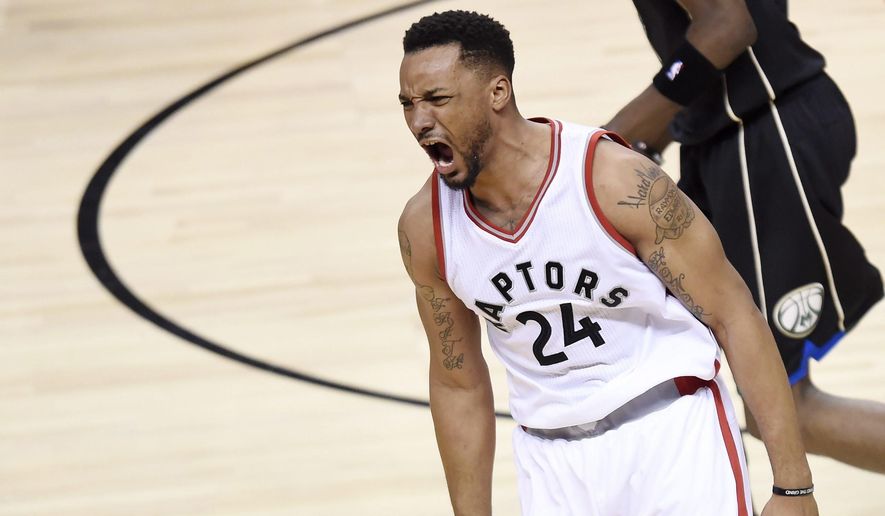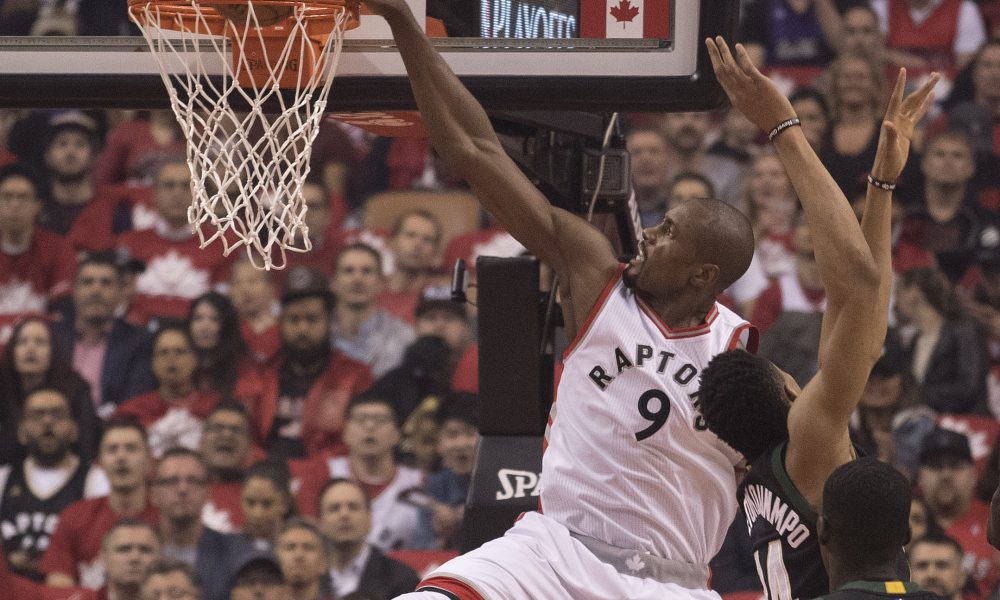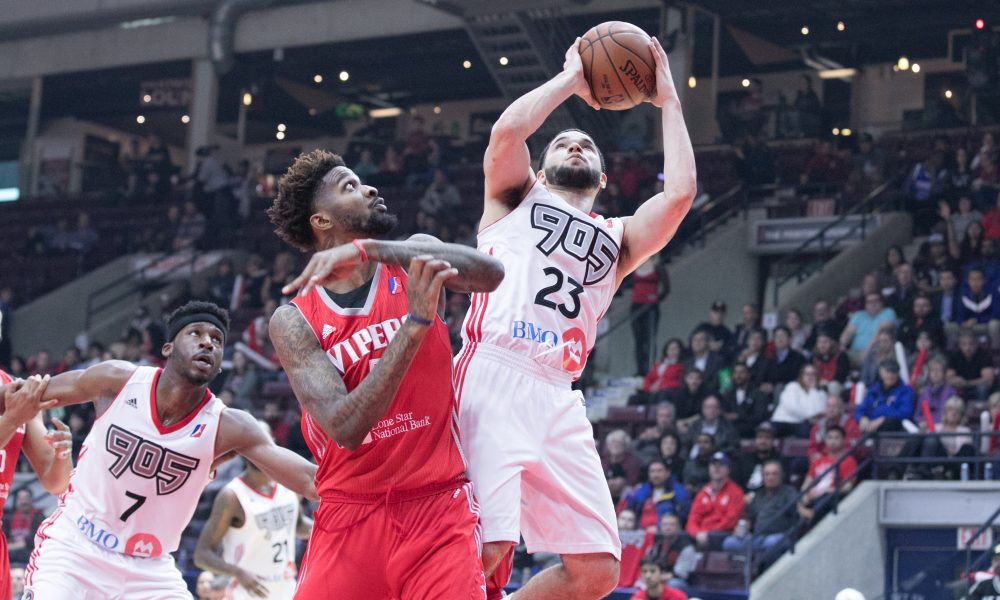Norman Powell. Just the name alone probably makes the rest of the NBA wonder…who? With an old fashioned name like that, his relatively lesser-known status in the 2015 Draft, and time spent in the D-League, there’s almost nothing about Norman Powell that says “household name”. And yet, here are we are, for the second straight year in the playoffs, praising this guy as the saviour of the Raptors’ playoff lives.
So how exactly has Norm brought his to game to this level in the playoffs? Based on my experience watching this team closely over the past two playoff runs, it really seems like a combination of factors, most notably (1) Powell’s ability and game-readiness, (2) Dwane Casey’s willingness to play Powell, as well as (3) the way the Raptors’ playoff opponents have defended.
Norman Powell can play
Norman Powell can play, there’s no question about that. As a former track-and-field star growing up San Diego, during his time in high school, Powell was heavily recruited by UCLA, and turned down basketball scholarships from San Diego State, Arizona, and Oregon. As a college athlete, Norm was known for his break-away speed, athleticism, and defensive abilities. When he was drafted 46th overall in the 2015 NBA Draft by the Bucks, who traded his rights to the Raptors as part of the Greivis Vasquez trade, Powell was viewed by the Raptors’ Masai Ujiri and Jeff Weltman as a first-round talent hiding as a gem in the second round. And as Dwane Casey made reference to in his podium appearance after Game 5, the Raptors knew right when they worked Powell out in preparation for the Draft, it was his toughness and physicality that would make him the fit they needed. That rang especially true after the Raptors’ first round exit in 2015 at the hand of the Wizards, with a collapsing unit that lacked playoff-level toughness at both ends of the floor.
Not surprisingly, Norm Powell quite quickly seemed to be ahead of the curve. As a D-League standout in his first year, Powell put NBA scouts and Raptors’ coaches on notice instantly. In 8 games with the Raptors905, Powell averaged nearly 25.0 points per game, on 50.0% from the field, 33% from 3, to go along with nearly 5 assists per game and 5.1 rebounds per game. While his outside shooting looked like it needed work, it was clear that he could hit a set shot when open, and he kept defenders honest with his ability to the drive the ball to the rim seemingly easier than anyone on the court.
So it’s no surprise that when Powell made his way to the NBA, most of those skills translated. He was a streaky 3-point shooter that could drill open shots, and his explosive ability made him a constant threat to drive or generate easy fast-break opportunities. So while we could point to the X’s and O’s, playoff matchups, lineups, etc., most of this is just due to the fact that Norman Powell is a very good prospect. He’s still a young player, who’s had some issues finishing at the rim and sustaining his shooting over 82 games, making him inconsistent in the regular season. But for the sake of giving credit where credit is due – let’s first recognize that Norman Powell is very good, and Masai Ujiri deserves credit for making that trade with Milwaukee.
Casey’s willingness to play Powell
So this point is a bit confusing – if Casey deserves credit for inserting Powell into the lineup, which has created such an obvious advantage for the Raptors, does he also deserve blame for not inserting him earlier in the first 3 games, where the Raptors could’ve certainly used him? While I’m not exactly sure where I land on that front, I will say that life has been tough for the second year player. From night to night, Powell never seemed to know if he’d play in the regular season, and the way the season finished, it looked like Powell was basically out of the playoff rotation.
Even though Norm played in 76 of the 82 games he dressed, his minute usage was extremely sporadic. One night he could be glued to the bench after the second quarter, while the next night, he might be part of the finishing unit in the second half. It was this kind of perplexing usage from Casey that likely made Powell who he is today. It required him to stay game-ready no matter what. And that meant getting practice shots up on a daily basis, keeping his stroke sharp from the outside, and defending with the requisite energy to keep himself on the floor.
Part of that was due to the Raptors’ added depth this year, especially after the trade-deadline acquisitions of Tucker and Ibaka. If the acquisitions were for anyone else, the loss of T. Ross would make you think Powell would automatically be the first shooting option off of the bench. But with extended minutes for Tucker, Ibaka, and Patterson as part of successful closing lineups, Powell’s usage, production and minutes continued to dwindle, leaving all of us to wonder if he was a redundant piece of the puzzle, or just going through a tough stretch.
But as the saying goes – desperate times call for desperate measures. And while we’re used to perplexing lineup shuffles from Dwane Casey in the playoffs, this year has been a new level. From Jakob Poeltl, to Norm Powell to Delon Wright, Casey seemed to roll the dice a few times early in this series, and Game 3, albeit a blowout, was no different. Powell fought for minutes in the second half of that contest, when the result was basically known by halftime. And even in those minutes, a clear strategy seemed to be manifesting itself.
The strategy of using Powell
The Milwaukee Bucks employed a classic Raptors playoff game plan in Games 1-3. Trap the ball handler hard off of pick-and-rolls (i.e. Lowry and DeRozan), and force them to make a play under duress. It was obviously something that the Raptors expected, but didn’t respond to. But the clear thing was that even when they did respond to it, it required a quick pass, and the ability of others on the floor to either (1) attack the rim using quickness or (2) hit open jumpers. Dumping the ball inside to a slow-footed JV was not going to be useful, and Serge Ibaka, DeMarre Carroll, Patrick Patterson, and PJ Tucker were, for the most part, bricking those resulting open jumpers. And if the pass to those guys wasn’t executed perfectly, it would mean a turnover, leading to easy Bucks dunks on the other end spearheaded by the Greek Freak. It was a simple defensive game-plan that was paying sizable dividends for Jason Kidd.
Enter Norman Powell. When Casey made the call to insert Norm into the starting lineup for JV prior to Game 4, I was already psyched. Not only because any change would’ve done the Raptors done some good, but because this one really made tactical sense. If Lowry and DeRozan made the reads we’d like them to out of those traps, this adds one more playmaker on the floor. Someone who can knock down the open 3, attack a close-out aggresively, and make a play off the dribble more quickly than someone like JV. It was a subtle change that completely changed the complexion of the offense, given the style defense the Bucks were playing. Here’s a look into what the offensive numbers looked like before and after the Powell insertion into the starting lineup:
Games 1-3 (JV in starting lineup):
Offensive rating: 95.4
Field goal percentage: 39.5%
3-point shooting: 25/74 (33.8%)
Assists per game: 16.7
Games 4 & 5 (Powell in starting lineup):
Offensive rating: 106.8
Field goal percentage: 49.0%
3-point shooting: 17/49 (34.7%)
Assists per game: 22.0
While the 3-point shooting in Game 3 brought these stats down just a tad, the field goal shooting in Game 5, and the overall passing and offensive fluidity has markedly improved. The presence of another playmaker on the floor who can attack off the dribble, as well as the Raptors’ increasing sensitivity to Milwaukee’s traps is punishing the Bucks’ defensive schemes. Not to mention Norm has been a perfect 7/7 from deep in the past 2 games, taking and making the right shots within the flow of that offense.
Mix all of this with Norm’s defense on Khris Middleton (who started the first 3 games averaging 17 points per game, and is now averaging just 9 points per game in the past 2 games), and it’s a surprising recipe for success. The only question now is how will Milwaukee respond? Putting a longer and more capable defender on Norm would mean taking some resistance away from Lowry and DeMar, while starting Greg Monroe to force Casey’s hand for not playing JV may come back to bite the Bucks defensively. So I’m not really sure if there is an answer for Milwaukee.
But as we saw from the Raptors last year, closing a team out on the road in Game 6 has always proved to be a tall order. So some letdown from Toronto is plausible. But if they can somehow stick to the game plan that worked in Games 4 and 5, and treat this thing like it really is a Game 7, they just might be unstoppable.



